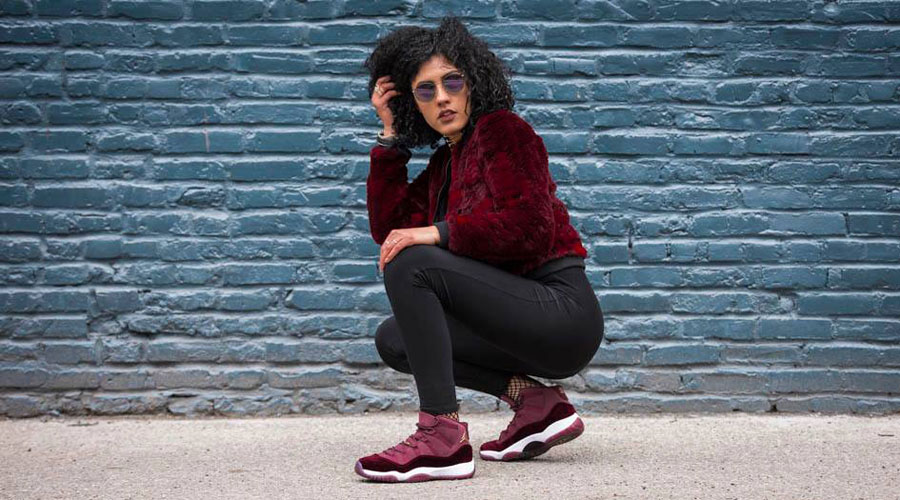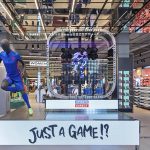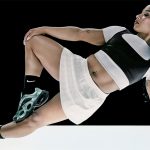By Thomas J. Ryan
Despite gains in footwear sales, shares of Finish Line Inc. (Nasdaq:FINL) fell more than 10 percent December 21, after the retail chain lowered its earnings forecast for the year due to subpar sales of apparel and accessories in its fiscal third quarter ended November 26.
In the quarter, the company lost $40.4 million, or $1 a share, nearly double the deficit of $21.8 million, or 49 cents, incurred in the year-ago period. On an adjusted basis, excluding severance-related charges, the company posted a loss of 24 cents a share, which compared to a loss of 18 cents a share expected on average by Wall Street.
Consolidated net sales in the quarter were $371.7 million, up 3 percent from a year ago. Same-store sales at its flagship Finish Line chain inched up 0.7 percent, far below the 7.4-percent growth expected by analysts polled by Consensus Metrix.
“While significant parts of our business did well during the third quarter, clearly there’s more work to do, particularly with soft goods, to drive consistent growth and improved profitability,” said Finish Line CEO Sam Sato on the company’s December 21 conference call with analysts.
Sato noted that following the back-to-school season, Finish Line had expected sales to “improve meaningfully” over the remainder of the third quarter due in large part to easier comparisons, as the supply chain disrupted year-ago results. October and November, however, were more challenging than officials expected, marked by weak traffic trends.
The 0.7-percent comp gain at Finish Line included a mid-single-digit increase in November, but that was well below expectations for a gain in the high-single-digit range. Overall, comps for the retailer were down 1.6 percent in September, down 2.1 percent in October and up 5.2 percent in November.
Apparel Comps Cut In Half
The culprit for the sales shortfall was soft goods, where comps tumbled 37 percent as both apparel and accessories significantly underperformed expectations. On the apparel side, comps were down almost 50 percent versus plans for the business to be up modestly in the quarter. Softer-than-expected demand for cold-weather gear more than offset gains in less seasonable categories. Apparel represented approximately half of the soft goods shortfall versus plan.
Finish Line continues to rework apparel by narrowing assortments, enhancing its branded offerings with a heightened focus on key items and deemphasizing its licensed apparel collections. “Our go-forward strategy also involves exiting our entry-price-point NCAA fleece program,” added Sato. “This has been a big driver in the back half of the year, but a negative contributor to our profit margins. Therefore, we planned this business down significantly year over year, but it, too, missed our forecast.”
Meanwhile, accessories were down by mid-teen percentages. Declines were seen across the board. In total, soft goods accounted for approximately 9 percent of its third-quarter sales compared with 15 percent a year ago. Added Sato, “Looking ahead, we expect the category to remain challenging in the near term, and this has been factored into our revised full-year guidance.”
Better News In Footwear
In its core footwear category, comps increased in the high single digits, driven by strength in running, basketball and athletic casual. Footwear’s performance was in line with its projected range, albeit toward the lower end as elements of its offerings underperformed versus plan.
Similar to the first half of the year, retro, running and basketball shoes, along with the latest casual running styles from several brand partners, saw strong demand. For the quarter, running comps increased low single digits, basketball grew high single digits and casual was up strong double digits.
Men’s footwear posted a mid-single-digit comp increase, driven by demand for multiple Nike retro running styles, including Huarache, Max 90 and Presto along with the new Huarache Ultra. Adidas Ultra Boost, AlphaBounce and NMD platforms all continued to sell through at a fast pace. Men’s basketball was dominated by retro and retro-inspired products from Jordan, along with the continued expansion of Under Armour’s Steph Curry line. Ongoing demand for Curry 2.5, combined with the launch of Curry 3 during the quarter, translated into strong year-over-year gains for the Under Armour franchise. Nike Soldier 10 and Kyrie also performed well. Stated Sato, “Collectively, these platforms helped offset some softness within the remaining areas of the category.” Casual footwear “remains on fire,” according to Sato. Classic models from Adidas led by Superstar, along with retro running styles from New Balance, Reebok and Puma, drove the casual comp gains in men’s.
In women’s, footwear comps increased by mid-teen percentages, led by multiple running and lifestyle products from several of its brand partners. Pegasus, Huarache, Huarache Ultra and Roshe from Nike were top performers, as were Adidas Ultra Boost and PureBoost X in running and Superstar and NMD from the Adidas Originals collection. Puma’s business accelerated in the quarter, fueled by demand for women’s-only product such as Fierce and multiple styles from Fenty x Rihanna. “The work we’ve done to grow our women’s business is yielding positive results,” Sato said. “This has included expanding our assortments with more premium materials and seasonal variations of key styles, as well as incremental marketing programs targeting female consumers such as our current #WeAreMore campaign.”
Kids footwear increased high single digits on a comp basis. The gains were driven by a balance mix of performance and retro styles from Nike, Brand Jordan and Adidas, along with strong demand for Under Armour’s Curry basketball shoes.
In-Store Shops Shine
In other business segments, Finish Line’s in-store shops inside Macy’s are exceeding expectations with a 33.2-percent jump in sales in the quarter. Revenue drivers include the expansion of kids footwear to 275 doors, up from 240 in the second quarter and 150 at the start of the year, as well as expanded kids assortments online. Kids accounted for 15 percent of the Macy’s business and is expected to grow higher in the coming quarters, officials said.
Finish Line’s Macy’s business is also being helped by the expansion of assortments available to Macys.com and increasing store fulfillments, which is driving conversion rates higher. Digital sales surged 108 percent and represented approximately 24 percent of the total volume in the third quarter. Finally, Macy’s shop expansion and relocation program repositioned or expanded another 38 shops in the quarter on top of the 108 completed since the program’s inception to expand sales.
Macy’s is expected to exceed the high end of its long-term goal of annual sales of $350 million.
JackRabbit Decision Coming
Regarding JackRabbit, Finish Line officials re-noted earlier news that on November 15 it had decided to explore a potential sale of the run specialty business and it is now being reported within discontinued operations. Peter J. Solomon Company LLC has been hired to assist in exploring a sale. Said Sato, “We believe our long-term growth strategy and profitability improvement plan aligned with simplifying the business to focus on The Finish Line brand. The process is proceeding, and we expect to have news to share with you later in the fourth quarter.
Forecast Lowered On Promotional Environment
Looking to the current quarter, Finish Line experienced strong digital sales over Black Friday weekend and during the first few weeks of December before traffic began shifting more heavily to brick-and-mortar this past weekend. Said Sato, “The selling environment has been more promotional in the last year, and we expect this trend to continue through the remainder of the fourth quarter.”
Discussing some strategies put in place since Sato took over as CEO earlier this year, Finish Line’s newest store format was extended to 27 additional locations. The format is seeing an “extremely positive” reaction from store associates, vendor partners and customers and post-remodel sales “have been encouraging,” said Sato. A “significant portion” of Finish Line’s banners are expected to be updated over the next several years. The company also closed six locations as part of its store optimization initiative. It has closed 71 over the past 21 months and plans to close another seven to 10 over the remainder of the year.
On the digital front, a new commerce platform has enabled increased traffic capacity and the order throughput to support busy launches or seasonal selling. Mobile traffic increased more than 19 percent in the quarter, accounting for two-thirds of its total digital traffic. Finish Line is also seeing a “very positive” response to its Shoes So Fresh campaign that features tie-ins with hip-hop artists.
Organizationally, Finish Line is fully reaping the benefits of a new warehouse and order-management system and seeing stronger-than-expected productivity gains in DTC fulfillment and store deliveries.
For the company’s current year, which ends in February, Finish Line cut its adjusted earnings estimate to a range of $1.24 to $1.30 a share from its prior outlook of $1.50 to $1.56 a share. The company also now sees same-store sales flat to up 1 percent, versus previously anticipating an increase of 3 percent to 5 percent. For Finish Line’s fiscal fourth quarter, the company expects a same-store-sales decline of 3 percent to 5 percent and adjusted earnings from continuing operations of 68 cents to 73 cents a share. Analysts expected 95 cents a share.
Photo courtesy Finish Line
















